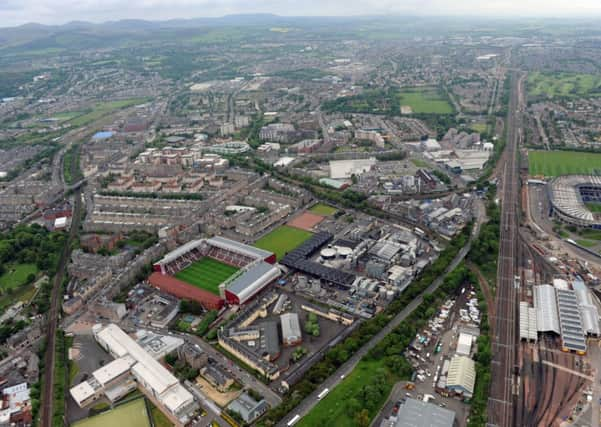Legionella victim’s widow ‘disappointed’ at probe


A long-awaited Crown Office probe has stated that finding the source of the outbreak which claimed four lives has “proved impossible” and that there will be no prosecutions in the wake of the 2012 outbreak which swept across the south west of the city.
In total 92 people were infected with the disease while hundreds more became ill after breathing in the bacteria.
Advertisement
Hide AdAdvertisement
Hide AdCatherine McDonald’s partner Robert “Bert” Air, 56, passed away after contracting the illness while working at a building site in Gorgie Road. She was informed of the Crown’s findings with the families of other victims at a meeting yesterday: “I am hurt, angry and disappointed at the outcome of the meeting today – I simply cannot express the frustration that I feel.
“We have waited so long to reach this point but I don’t feel we have been provided with any answers as to what happened. I still want to know why Bert died.”
The father-of-two had been rushed to the Edinburgh Royal Infirmary with suspected pneumonia before the true extent of the legionnaires’ crisis was known. No decision has yet been made on whether or not to hold a Fatal Accident Inquiry amid growing demands from victims families.
However Elaine Russell, a partner at Irwin Mitchell, whose firm is representing 40 people affected by the fatal disease, has said that such an inquiry is “crucial”.
Advertisement
Hide AdAdvertisement
Hide AdShe said: “Three years ago four people lost their lives and almost 100 suffered from Legionnaires’ disease, yet the authorities are no closer to knowing what the source of the illness was.
“The families affected want answers as to what caused such suffering across the city and we now believe that a Fatal Accident Inquiry is crucial in determining what happened back in 2012.”
As a result of the investigation a number of reports were submitted to the Crown Office for breaches of Health and Safety regulations and a number of companies are to be prosecuted in relation to these breaches.
The outbreak is believed to have started in the Gorgie area of the Capital, and investigations centred on two firms – the North British Distillery and pharmaceutical company Macfarlan Smith. Both were served with improvement notices in relation to cooling towers, which can be a source of the legionella bacteria.
Advertisement
Hide AdAdvertisement
Hide AdEdinburgh Central MSP Marco Biagi has said that the decision not to prosecute any individual or organisation over the 2012 outbreak will leave victims and their families “devastated”.
The Health and Safety Executive (HSE) said the investigation, which saw a team analyse samples from several sites, was one of the most complex it has ever undertaken.
Timeline of Legionella outbreak
31 May 2012: First case of legionnaire’s disease reported to NHS.
3 June 2012: Outbreak declared.
3 June 2012: Initial sampling at potential source sites commenced by City Council.
5 June 2012: Death of
Bert Air.
Advertisement
Hide AdAdvertisement
Hide Ad8 June 2012: HSE issues improvement notice to a company situated in Gorgie.
11 June 2012: HSE issues two improvement notices to second company in Gorgie.
14 June 2012: Death of Sean Ferguson.
30 June 2012: Death of John Lonnie.
15 July 2012: Death of Sylvia Riddell.
Sept 2013: HSE submits its first interim reports to Crown Office and Procurator Fiscal Service (COPFS).
April 2014: HSE completes its investigations
1 August 2014: COPFS internal meeting to discuss cases reported.
Advertisement
Hide AdAdvertisement
Hide Ad22 September 2014: Information received from Edinburgh City Council in relation to outbreak investigation work.
20 October 2014: Report submitted to Crown counsel.
15 January 2015: Crown counsel issues preliminary view for internal COPFS discussion.
2 April 2015: Crown counsel’s instructions issued.
probe complications laid bare
University of Edinburgh scientists have attempted to explain why tracing the source has proven to be more complicated than hoped.
A DNA study of bacteria samples taken from patients infected during the outbreak shows that it was caused by several subtypes of the bacteria.
Advertisement
Hide AdAdvertisement
Hide AdThe unexpected discovery means tracing the source of this – and any future outbreaks – will be challenging.
In a bid to prove where the infection came from, scientists at the university’s Roslin Institute attempted to grow samples of Legionella – the bacteria that causes Legionnaires’ disease – from water samples taken from the suspected source. Legionella is difficult to grow in the laboratory and attempts to do so proved unsuccessful.
The team worked with the University’s Centre for Immunity, Infection and Evolution, the Royal Infirmary of Edinburgh and the Scottish Microbiology Reference Laboratories.
Professor Ross Fitzgerald, who led the study, said: “Genetic analysis is a powerful tool to help us track outbreaks of infectious diseases. Unfortunately, our findings suggest that it may be very challenging to prove conclusively where the outbreak came from, which will make it difficult for investigators to prosecute those responsible.”